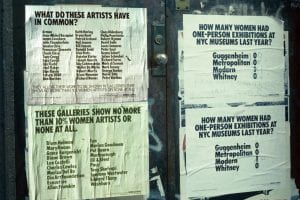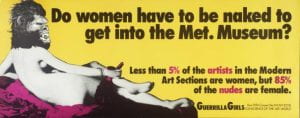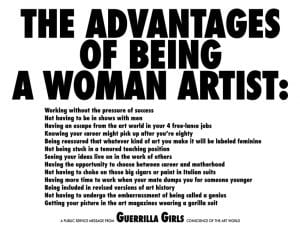Beautiful Trouble: The Guerilla Girls
In February Pace NYC will be hosting the Debating for Democracy Conference, an annual event organized through the CCAR’s partnership with Project Pericles. This year we will be welcoming artist-activist trainers from Beautiful Trouble – a book and website “whose mission is to make grassroots movements more creative and more effective.” Every few weeks until the event CCAR staff members will be highlighting a case study from the book that they found particularly motivating. Here Program Coordinator, Erin Mysogland, shares her thoughts on the Guerilla Girls!
At the end of Beautiful Trouble the authors highlight practitioners of creative artist-activism, who they explain are “the shoulders we stand on.” I was excited to see the Guerilla Girls listed as practitioners and took this as an opportunity to learn more about them!
In 1984, the Museum of Modern Art launched an exhibition entitled “An International Survey of Recent Painting and Sculpture.” Despite its claim to being a display of the “richness and diversity of recent artistic production,” only 13% of artists in the exhibition were female and the majority were white artists from Europe or North America. A group of women took issue with this obvious exclusion and plastered posters around the city denouncing MOMA’s failure to exhibit female artists and artists of color. As their protest gained traction, these women took the names of dead female artists, such as Frida Kahlo, and began donning gorilla masks, thus beginning the Guerilla Girls.
Some of the Guerilla Girls’ early posters around the city.
Culture Jamming
The authors of Beautiful Trouble outline how the Guerilla Girls practice the tactic of culture jamming – the subversion of a well known image/artifact. For instance, in order to criticize the ubiquity of female nudes yet absence of work by female artists in museums, the Guerilla Girls created a poster with a gorilla head on a female body. The work intentionally recalls a famous work of art history, Jean-Auguste-Dominique Ingres’s La Grande Odalisque, and the fact that the Guerilla Girls’ icon is placed over the painting allows them to reclaim female identity in classical art.
What I enjoy most about the Guerilla Girls is their use of humor. In a further effort to raise awareness about sexism in the art world, the Guerilla Girls produced a list of “the Advantages of Being a Woman Artist” which humorously highlights the experience of women professionals. Although the Guerilla Girls produced this print in 1988, many of the statements still ring true today. Some of my favorites include: having to work” 4 free-lance jobs,” “having the opportunity to choose between career and motherhood,” and “seeing your ideas live on in the work of others.” The Guerilla Girls demonstrate the utility of humor for succinctly and directly raising awareness about injustice. While racism and sexism obviously still exist in the art world, and society at large, there is something to be said for the role of the Guerilla Girls is bringing these issues visibly to the surface.
The work of the Guerilla Girls is blunt, sarcastic, and pioneering. The group remains active today and their work, including the images included here, can now be found in some of the Museums they formed to criticize. While this inclusion leaves me with many questions – how can activists remain innovative when their initial arguments are accepted by mainstream society? How do artist-activists evaluate the success of their work? – I know that the Debating for Democracy conference in February will allow me the chance to reflect on some of them. Ultimately, the Guerilla Girls remain an engaging example of creative and intersectional fights against sexism and racism and are quickly and expertly captured by the authors of Beautiful Trouble.
Students interested in attending the Debating for Democracy Conference on February 28th should email emysogland@pace.edu or vpawa@pace.edu for more information!
Sources:
- https://www.guerrillagirls.com/
- https://www.tate.org.uk/art/artists/guerrilla-girls-6858









